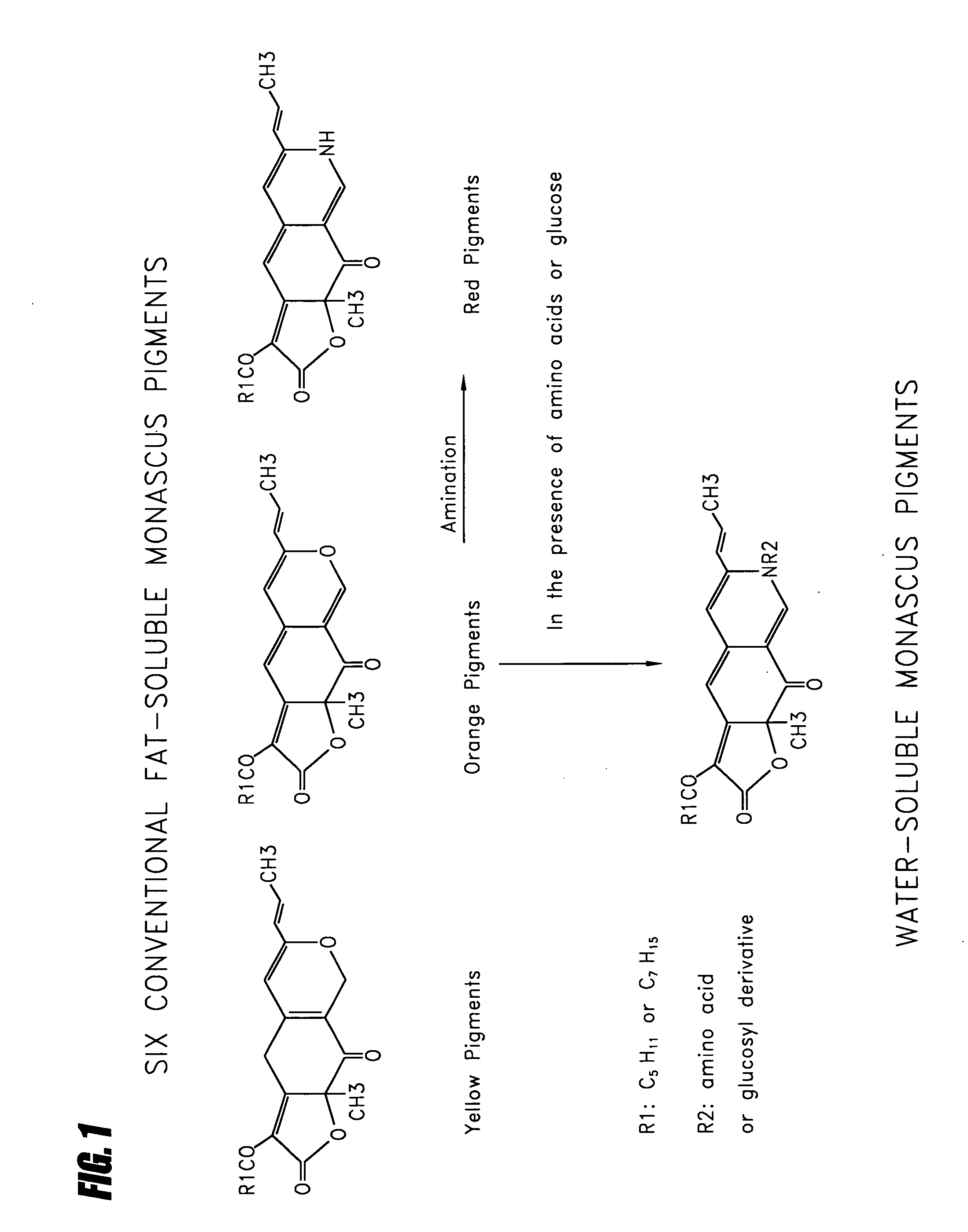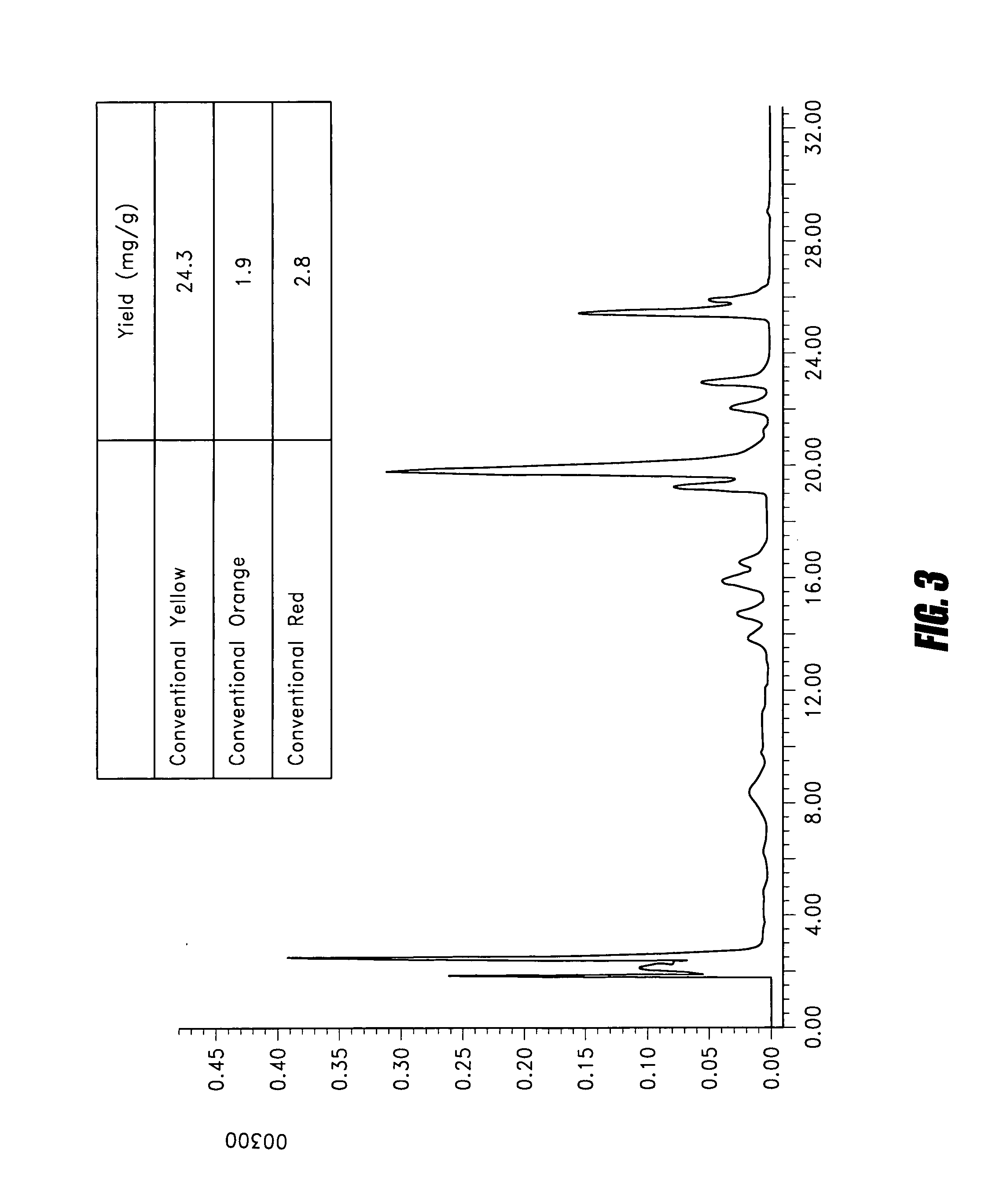Method for preparing citrinin-free Monascus biomass and use of citrinin-free Monascus biomass
- Summary
- Abstract
- Description
- Claims
- Application Information
AI Technical Summary
Benefits of technology
Problems solved by technology
Method used
Image
Examples
example 1
Submerged Fermentation for Monascus purpureus
Sources of Monascus purpureus
[0070]Monascus purpureus strain IM 888 was maintained at 30° C. in a mushroom complete medium (CM; Raper & Miles 1958) (Chiu & Poon, 1993).
Preparation of Inoculum
[0071] A seed culture was prepared by blending a 7-day old fully grown CM plate culture (9 cm diameter plate containing 20 mL medium) with a 20 mL distilled water, and the resultant mycelial homogenate was inoculated into a 100 mL CM and incubated at 32° C. at 200 rpm in a shaker under continuous illumination (Innova 4340 illuminated refrigerated incubator shaker, New Brunswick Scientific) for 7 days to obtain an inoculum for use in the next step.
[0072] A semi-defined broth containing a 25% cane juice (v / v diluted with distilled water) and 1% monopotassium glutamate by weight was prepared as a fermentation medium.
[0073] The medium was determined and found to contain: glucose 7 g / L, sucrose 12 g / L, protein 140 mg / L, phos...
experiment 1
Color & Nitritional Analyses
Analysis of Monascus Biomass
[0080] The biomass prepared by Example 1 was extracted with 90% ethanol at a ratio of 1:100 (w / v) for 2 h, and the extract was dried by rotary evaporation at 50° C. (BUCHI Rotavapor R-114 and BUCHI Waterbath B-480). The residue was redissolved in 1 mL methanol (HPLC grade), membrane-filtered (0.45 μm membrane, Acrodisc 4CR, PTEE) and analysed by HPLC conditions stated below.
[0081] As shown in FIG. 3, there are multiple red compounds present in the alcohol extract of the Monascus biomass with absorbance at 500 nm. Only the standards for conventional pigments are available. Thus quantification is done for these conventional pigments with the following procedures.
[0082] Five gram of the freeze-dried fungal biomass was first extracted with 100 mL n-hexane overnight.
[0083] The hexane-soluble fraction was dried by rotary evaporation at 40° C. Then 20 mL of absolute ethanol were added. The alcohol phase was pipetted out and drie...
experiment 2
Bioactivity Test
1. Antioxidation Capacities
[0103] A freeze-dried sample of Example 1 was weighed and made up to 100 mg / mL in distilled water. The solution was autoclaved at 121° C. for 15 min. The supernatant was harvested after centrifugation at 4° C. was stored at −20° C. A serial dilution was then made with the stock aqueous extract into a series of increasing concentrations of the extracts up to 100 mg / mL solution. For the assay of the scavenging of DPPH radicals, a methanolic extract (membrane-filtered; 0.45 μm membrane, Acrodisc 4CR, PTEE) (replacing the solvent water with methanol and procedure stated in the first sentence) was used instead.
Assay for Inhibition of Lipid Peroxidation
[0104] Normal rats were sacrificed by cervical dislocation. The liver of the rats was rapidly homogenized in 0.25M of an ice-cold sucrose solution and the resultant solution was centrifuged at 12,000×g for 20 min at 4° C. The supernatant obtained was centrifuged at 15,000×g for 60 min at 4° C...
PUM
 Login to View More
Login to View More Abstract
Description
Claims
Application Information
 Login to View More
Login to View More - R&D
- Intellectual Property
- Life Sciences
- Materials
- Tech Scout
- Unparalleled Data Quality
- Higher Quality Content
- 60% Fewer Hallucinations
Browse by: Latest US Patents, China's latest patents, Technical Efficacy Thesaurus, Application Domain, Technology Topic, Popular Technical Reports.
© 2025 PatSnap. All rights reserved.Legal|Privacy policy|Modern Slavery Act Transparency Statement|Sitemap|About US| Contact US: help@patsnap.com



